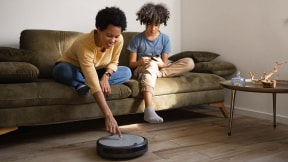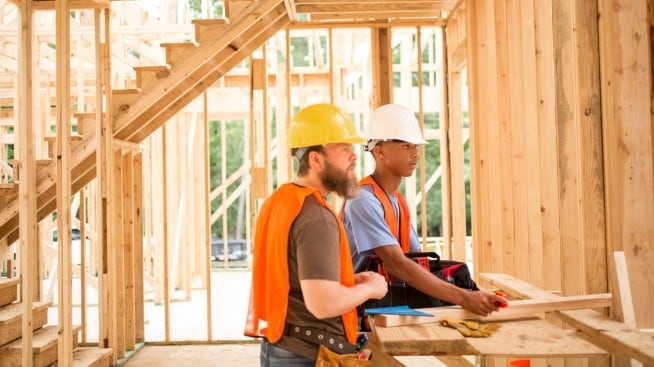What is a smart home?

Living spaces that anticipate your needs, streamline your daily routine and offer complete control — smart homes are transforming the way we live… but what is a smart home, exactly? A smart home is a living space equipped with advanced technology that enables automation, remote control and real-time monitoring of various home systems and appliances. A smart home could, for example, allow you to control your thermostat, lights and security system with just a few taps on your smartphone — whether you’re on the couch or on your way to work.
For individuals with different physical abilities, smart homes may also provide increased accessibility and independence through features like voice commands and smartphone app controls. Let’s dive into smart homes, how they work and what they might have to offer over a traditional home — and where they might fall short.
How smart homes work
Smart homes are designed to create a seamless, interconnected living environment by consolidating the management of various devices and systems within your home. This interconnected smart home system typically relies on a central control hub or a collection of apps that allow communication between devices and grant users control from any location.
The core design principle of smart homes is adaptability, aiming to cater to your preferences and lifestyle. To achieve this, smart homes employ innovative technologies that learn from your daily habits and routines. This allows the home to adjust itself accordingly, enhancing comfort, convenience and efficiency while potentially minimizing energy consumption and waste.
Components of a smart home technology
Smart homes are composed of a few different classes of devices and systems that work together as one. Let’s take a look at each of these pieces to see how they contribute to making your home a little smarter— and potentially more valuable.
Smart home devices
Smart home devices are individual gadgets and tools that are made a little “smarter” than their traditional counterparts, typically via internet connectivity. Smart home devices could include smart thermostats, video doorbells, smart locks, voice-controlled speakers and more. These devices often communicate with your smartphone or central hub to integrate into your smart home’s broader ecosystem.
Smart home appliances
Smart home appliances, such as smart fridges, ovens or washing machines, typically feature more advanced technology and connectivity features that may help reduce workload and automate many chores and activities. Many can be controlled remotely, programmed to run on specific schedules or attuned to your preferences over time. For example, a smart fridge might be able to monitor its own contents, suggest recipes based on available ingredients or even order groceries when you’re running low on supplies.
Smart home systems
These are the overarching frameworks that connect and coordinate all of the subordinate devices and appliances within your home. Some common smart home systems include home security and monitoring, lighting control and energy management systems. Integrating your devices and appliances onto a smart home system could get your smart home working like a more cohesive unit, potentially offering a more convenient, efficient and secure living experience.
Advantages and disadvantages of a smart home
Smart homes may not be for everybody. As with any technology, smart homes come with their own set of advantages and disadvantages that might be worth weighing before deciding to invest in one. Let’s discuss some of their more significant advantages and disadvantages to help you decide if a smart home should be your new home.
Smart home advantages
- Convenience: One of the primary goals of a smart home is to make life more convenient through the ability to control and automate various aspects of your home with your smartphone or voice commands. Being able to access and control these gadgets from your cell phone helps save time and provides reassurance for different scenarios.
- Energy efficiency: Smart home features that attune to your preferences and routines might lead to reduced energy expenditure. This could possibly benefit both the environment and result in cost savings on certain utility bills.
- Enhanced security: Smart home security systems and devices, such as video doorbells and smart locks, may provide an added layer of protection for your property. Real-time alerts and remote access features could allow you to monitor your home and respond to potential threats, even when you’re away. For example, providing reassurance that a door is locked or a garage is closed.
Smart home disadvantages
- Cost: One of the main drawbacks of smart home technology might be its upfront cost. Smart devices and appliances are typically more expensive than their traditional counterparts and installing a comprehensive smart home system may constitute a significant financial investment.
- Privacy concerns: As smart home systems rely on connectivity and data collection, privacy concerns may arise. While smart home systems typically employ security measures to protect user data, it could be worthwhile to consider your own comfort level in regard to information-sharing with device manufacturers and service providers.
- Compatibility and complexity: With a wide range of smart home devices and systems available, compatibility between different brands and products could prove a challenge. Additionally, setting up and maintaining a smart home could potentially require technical knowledge and awareness of ongoing updates.
Smart home ideas
If you're considering integrating smart technology into your living space, there are countless smart home ideas to consider that might make life a little more convenient or improve accessibility. Here are just a few mainstream smart home ideas to get you started:
- Voice-controlled assistants: Voice-controlled smart speakers can act as the central hub for your smart home. They might allow you to control various devices with voice commands, play music, and even answer questions or provide information. This may be especially helpful for individuals with different physical abilities, allowing them to use their voice to generate specific commands to help keep things running smoothly at home.
- Smart lighting: Smart bulbs can be controlled remotely or programmed to turn on and off according to your schedule. Some smart lighting systems can even adjust the brightness and color based on the time of day or your preferences.
- Smart thermostats: A learning thermostat that can analyze your daily routines and adjust the temperature accordingly could be a way to save on energy bills.
- Smart security systems: Smart locks, video doorbells and connected security cameras allow you to monitor your home remotely and alert you to any unusual activity in real-time.
- Leak detection sensors: Smart water leak sensors placed in areas prone to leaks, such as under sinks or near appliances, could notify you if any water is detected, allowing you to address the issue before it becomes a more significant problem.
- Smart irrigation systems: Smart sprinkler controllers can help conserve water by adjusting watering schedules based on real-time weather data, ensuring your lawn and garden receive the optimal amount of water without wasting resources.
- Energy monitoring: Smart plugs or whole-home energy monitors to track your energy usage could help you identify areas where you can save energy and reduce your utility bills.
In summary
A smart home is a living space that integrates your home’s devices, appliances and systems to provide a more seamless, convenient and possibly more accessible living experience. While there are indeed many possible advantages a smart home might offer, there are some potential drawbacks you may want to consider as well before investing in one. By understanding smart homes, you can make more informed decisions about which smart home elements might help personalize and interconnect your own living environment.



